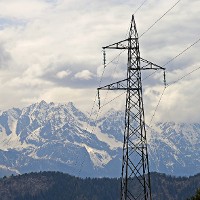Ecosystem services and bio-energy potential in the Alpine Space
In 2013, ESM-PSI and ESM-FEM continued to be involved in the "recharge.green" project. The project aims to analyze the bio-energy potential in the Alps from biomass, solar, wind, and hydro, while assessing the impact on a series of ecosystems services based on expert interviews that are being collected and ranked.
The developments and first results of the project are being closely followed by the different stakeholder groups, for example, the International Commission for the Protection of the Alps (CIPRA) and the World Wide Fund for Nature (WWF). These are among several organizations seeking advice from ESM on the development of guidelines and policies for sustainable renewable energy generation taking into account human health risk, environmental assessment and environmental science in the Alpine space [1].
ESM is the central modeling partner in the recharge.green project consortium and is contributing its integrated modeling cluster featuring the biophysical forest management model G4M and the renewable energy siting and scaling optimization model BeWhere.
The growing demand for renewable energy (RE) is increasing the pressure on the Alpine environment, strongly impacting land use patterns, ecological connectivity and biodiversity. Both the demand for renewable energy and the need for the conservation of biodiversity, soil, and connectivity transcend national borders. Thus, a transnational dialog to address multiple environmental objectives, interdependences, and trade-offs between various ecosystem services, and conflicting priorities, is urgently needed.
The projects' core objective is to develop tools and an integrated strategy for renewable energy production, sustainable land use systems, and conservation of biodiversity and soil across the Alpine region to support the implementation of relevant EU Directives.
Further, it will valorise Alpine biodiversity, land use patterns, and related ecosystem services, and model the carrying capacity of the Alpine ecosystems with respect to all aspects of RE production and consumption.

Figure 1. BeWhere projects the optimal location of green field bioenergy plants and G4M provides the information on biomass increment and availability under different forest management options. Picture on the left side: Harvesting location and intensity (brown [1,000 m3] under a carbon sequestration scenario (increment in green [tc/ha]). Picture on the right side: Harvesting location and intensity (brown [1,000 m3] under a maximum biomass for bioenergy production scenario (increment in green [tc/ha]). Source: [2].
Results shown in the figure were presented by IIASA’s Director General and Chief Executive Officer, Prof. Dr. Pavel Kabat at the European Forum Alpbach.
References
[1] Svadlenak-Gomez K, Badura M, Kraxner F , Fuss S, Vettorato D, Walzer C. (2013). Valuing Alpine ecosystems: the recharge.green project will help decision-makers to reconcile renewable energy production and biodiversity conservation in the Alps; eco.mont Journal on Protected Mountain Areas Research 05/2013; DOI:10.1553/ecomont-5-1s59 LGB.
[2] Kraxner F, Nordstrom E-M, Havlik P, Gusti M, Mosnier A, Frank S, Valin H, Fritz S, Fuss S, Kindermann G, McCallum I, Khabarov N, Bottcher H, See L, Aoki K, Schmid E, Mathe L, Obersteiner M (2013). Global bioenergy scenarios - Future forest development, land-use implications, and trade-offs. Biomass and Bioenergy, 57:86-96 (October 2013) (Published online 2 May 2013)
Collaborators
University of Veterinary Medicine Vienna, Austria;
Research Institute of Wildlife Ecology, Vienna, Austria;
European Academy of Bolzano/Bozen, Italy;
Institute of Geography, University of Innsbruck, Austria

Research program


